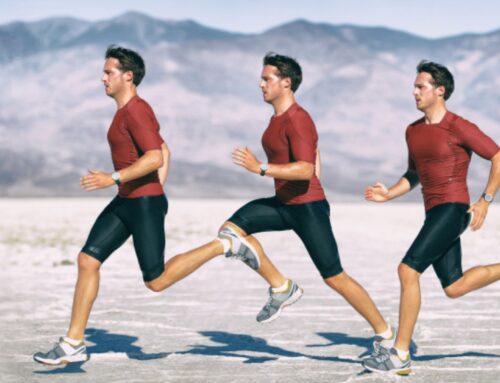Cross-training can help address some of the issues and most common cycling injuries that our clients and the cycling community experience. Cross-training can involve simple body weight exercises; it doesn’t have to involve a lot of heavy lifting or a lot of big equipment. Many of the exercises that we would prescribe to cyclist clients actually focus on the core.
In our post Exercises to Prevent the Most Common Cycling Injuries, we provide an outline of the types of exercises and direction that we would take with clients to prepare them for or repair them from the demands of road cycling.
In this post, we provide a template of a strength training program that can help prevent injuries from occurring and maximize your performance on the bike. A consultation with a registered physiotherapist can customize this program to your specific needs and goals to take your cycling to the next level.
Cross-Training Program for Cyclists
1. Rotational Plank
Starting from a basic front plank position rotate into a side plank position then back to front plank before rotating to the opposite side. This exercise is helpful in engaging not only the core muscles in the back, but also the sides of the trunk and lateral aspect of the hips.
- For this exercise, I like to hold each position for 3-5 seconds and continue for up to 45 seconds, 3 sets.
2. Rotational Bird-Dog
Here my goal is to try to touch my elbow to my knee without excessive rounding of my back. For this exercise, I like to focus on my form and ensure I’m not cheating by rounding or arching my back. In addition, I’m strong through my shoulders and my cue with my legs is to “reach with my heel.”
- I recommend 3-5 second hold, 6-8 reps preside, 3 sets.
3. Stationary Lunges
Stationary lunges are a great way to unilaterally train each lower extremity and encourages eccentric control of your body. In addition, it helps you practice your balance when in a functional position.
- I suggest trying body weight lunges first, and attempting appropriate form for 20 repetitions total.
4. Goblet Squats
Goblet squats are a great way to target the low back, glutes, hamstrings, quads, and the always- ignored, adductors (groin). Starting with a wider than usual stance, lower your body to the ground and ensure you feel tension through your lower body, but also your groin. Keeping the knees in line with your toes and cueing an outward push, stand up and lock out the knees. Try a light weight before moving onto the heavier ones.
- 10-12 reps with proper form at 3 sets will encourage muscle development, especially if you’re beginning your cross-training journey.
5. Step-Ups
Step-ups are a great way to train explosiveness in the lower extremity. Make sure to use your upper extremity for balance and to prevent sway in your knee. Try to tension the front leg first before stepping up and try not to assist with your back leg (easier said than done!). Body weight as your resistance is a great place to start. Remember that the explosiveness is what counts and ensure the lock out at the top.
- 15 repetitions per leg, 3 sets each will get your heart rate up and muscles stimulated.
6. Prone unilateral hamstring curls
Prone unilateral hamstring curls are often overlooked at the gym. Controlling the band is more difficult than it looks and it encourages the proper training of your knee’s movement pattern, into flexion. For beginners, try a light band and work your way up. Remember, the range of motion is important and try not to stop at 90 degrees of flexion. Your target is heel to bum!
- 8-10 repetitions, 3 sets per leg will be an ideal starting place.
7. Romanian deadlifts
Romanian deadlifts are one of the best value for exercises to perform at the gym. This exercise will strengthen the posterior chain of muscles including your shoulder stabilizers, spinal musculature, gluteal muscles, and hamstrings. No doubt, your heart rate will also increase quite a bit for a resistance exercise! With deadlifts, I encourage having some moderate to heavy weight for appropriate and meaningful stimulus through these larger muscles.
- 10-12 repetitions ; 2-3 sets will set you on the right path.
If you are a cyclist experiencing pain or injuries, or you would like to discuss ways to prevent injuries and maximize your performance, talk to one of our physiotherapists.
Written by

















